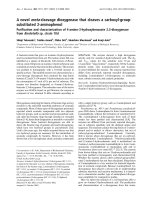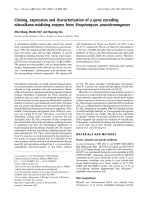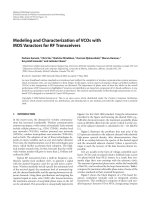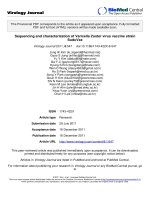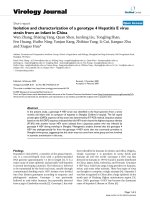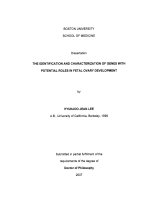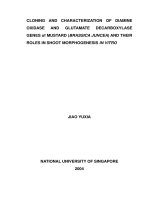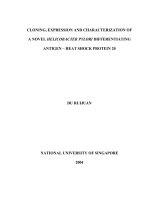Screening and characterization of streptomyces corchorusii strain l72 capable of antagonism with fungus sclerotium rolfsii
Bạn đang xem bản rút gọn của tài liệu. Xem và tải ngay bản đầy đủ của tài liệu tại đây (2.7 MB, 76 trang )
VIETNAM NATIONAL UNIVERSITY OF AGRICULTURE
FACULTY OF BIOTECHNOLOGY
- - - - - - - -
GRADUATION THESIS
SCREENING AND CHARACTERIZATION OF
STREPTOMYCES CORCHORUSII STRAIN L72
CAPABLE OF ANTAGONISM WITH FUNGUS
SCLEROTIUM ROLFSII
HANOI - 2022
VIETNAM NATIONAL UNIVERSITY OF AGRICULTURE
FACULTY OF BIOTECHNOLOGY
- - - - - - - -
GRADUATION THESIS
SCREENING AND CHARACTERIZATION OF
STREPTOMYCES CORCHORUSII STRAIN L72
CAPABLE OF ANTAGONISM WITH FUNGUS
SCLEROTIUM ROLFSII
Student nam
: NGO VAN ANH
Student code
: 637404
Class
: K63CNSHE
Supervisor
: Dr. PHAM HONG HIEN
: Assoc.Prof. NGUYEN XUAN CANH
Department
: MICROBIAL TECHNOLOGY
HANOI – 2022
DECLARATION
I hereby commit that the thesis is completely done by me under the
guidance of Assoc. Prof. Dr. Nguyen Xuan Canh, Dr. Pham Hong Hien. All the
data and results that I have provided in this study are true, accurate, and not used
in any other report. I also assure that the literatures cited in the thesis indicated
the origin and all help was thankful.
HaNoi, 5𝑡ℎ Deceber 2022
Student
Ngo Van Anh
i
ACKNOWLEDEGE
During the process of implementing my graduation project, I have received
a lot of attention and help from individuals and groups.
First of all, I would like to express my respect and deep gratitude to Dr.
Pham Hong Hien and Assoc. Prof. Nguyen Xuan Canh for giving me the
opportunity to carry out this work, and their huge efforts, enthusiasm, and support
throughout the duration of the undergraduate thesis.
Secondly, I would like to thank the teachers in the Faculty of Biotechnology
have helped and taught me during my training at university. Especially the
teachers of the Faculty of Biotechnology who gave me advice during carrying out.
Finally, I would like to sincerely thank my family members and friends who
always trust, support and encourage me to complete this report.
Sincerely thank!
HaNoi, 5𝑡ℎ December 2022
Student
Ngo Van Anh
ii
CONTENTS
DECLARATION ................................................................................................. i
ACKNOWLEDEGE ........................................................................................... ii
CONTENTS ....................................................................................................... iii
LIST OF TABLES ............................................................................................. vi
LIST OF FIGURES ........................................................................................... vii
LIST OF ABBREVIATIONS ............................................................................ ix
ABSTRACT ........................................................................................................ x
PART I. INTRODUCTION ............................................................................. 1
PART II. LITERATURE REVIEW................................................................ 3
2.1. Overview of peanuts..................................................................................... 3
2.1.1 History ........................................................................................................ 3
2.1.2. Biological characteristics .......................................................................... 3
2.1.3. The role of peanuts .................................................................................... 3
2.2. Some common harmful diseases in peanuts ................................................ 6
2.2.1. White mold root rot disease ...................................................................... 6
2.2.2. Rust disease in peanuts.............................................................................. 7
2.2.3. Germ rot disease in peanuts ...................................................................... 9
2.3. Overview of the Sclerotium rolfsii ............................................................. 10
2.3.1. General introduction the Sclerotium rolfsii............................................. 10
2.3.2. Growth characteristics of the Sclerotium rolfsii ................................. 11
2.3.3. Disease-causing characteristics ............................................................ 12
2.4. Overview of actinomycetes ..................................................................... 12
2.4.1. General introduction to actinomycetes ................................................ 12
2.4.2. Morphological characteristics of actinomycetes ................................ 15
2.4.3. Biochemical characteristics ..................................................................... 17
2.4.4. The role of actinomycetes ....................................................................... 17
2.5. Research situation in Vietnam and the world ............................................ 18
iii
2.5.1. Research situation in the world ............................................................... 18
2.5.2. Research situation in Vietnam ................................................................ 19
PART III. MATERIAL AND METHODS ................................................... 21
3.1. Material ...................................................................................................... 21
3.1.1. Location and time of the study ................................................................ 21
3.1.2. Material ................................................................................................... 21
3.1.3. Equipment and Chemicals....................................................................... 21
3.1.4. Medium ................................................................................................... 22
3.2. Methods ...................................................................................................... 23
3.2.1. Screening and selection of fungal antagonist Actinomycetes ............... 23
3.2.2. Morphological characteristics of colonies and spores ............................ 24
3.2.3. Research on cultural characteristics ........................................................ 24
3.2.4. Evaluation of the influence of cultural conditions .................................. 25
3.2.5. Investigation of biochemical characteristics ........................................... 26
3.2.6. Classification of the Actinomycetes based on 16S rRNA sequences ......... 31
PART IV. RESULTS AND DISCUSSION ................................................... 35
4.1. Screening and selection of fungal antagonist Actinomycetes ................... 35
4.2. Morphological characteristics of colonies and spores ............................... 36
4.3. Cultural characteristics ............................................................................... 37
4.4. Evaluation of the influence of cultural conditions ..................................... 40
4.4.1. Effect of temperature............................................................................... 41
4.4.2. Effect of pH ............................................................................................. 42
4.4.3. Salt tolerance ........................................................................................... 43
4.4.4. The ability to assimilate the source of Carbon ........................................ 45
4.4.5. Ability to assimilate Nitrogen source ...................................................... 46
4.5. Biochemical characteristics of actinomycete strain L72 ........................... 47
4.5.1. Extracellular enzyme production ............................................................ 47
4.5.2. Ability to produce IAA ........................................................................... 48
iv
4.5.3. Ability to solubilize insoluble phosphate ................................................ 50
4.5.4. VP Test ( Voges – Proskauser test) ......................................................... 53
4.5.5. MR Test (Methy red test) ........................................................................ 53
4.5.6. Test for catalase activity.......................................................................... 54
4.6. Classification of the actinomycetes based on 16S rRNA sequences ......... 55
4.6.1. Amplification of 16S rRNA sequences ................................................... 55
4.6.2. Sequencing PCR products and building a phylogenetic tree .................. 56
PART V: CONCLUSIONS AND PROPOSAL ............................................ 58
5.1. Conclusions ................................................................................................ 58
5.2. Proposals .................................................................................................... 58
REFERENCES ................................................................................................ 59
v
LIST OF TABLES
Table 3.1. Instructions for preparing the working standard solution IAA .......... 28
Table 3.2. Construct the concentration range of the standard curve ................... 30
Table 3.3. Primers for PCR ................................................................................. 33
Table 3.4. Components of PCR reaction............................................................. 34
Table 4.1. Rate of antifungal resistance of selected actinomycete strains .......... 35
Table 4.2. Growth characteristics of actinomycetes L72 on different media after
5 days of culture .................................................................................................. 38
Table 4.3. Biochemical characterization of actinomycete strain L72. ................ 55
vi
LIST OF FIGURES
Figure 2.1. White mold root rot disease on peanut and its causative agent .......... 6
Figure 2.2. Peanut leaves infected with the fungus causing rust disease.............. 8
Figure 2.3. Germ rot disease in peanuts ................................................................ 9
Figure 2.4. The fungus Rhizopus arrhizus .......................................................... 10
Figure 2.5. Schematic drawings of the different types of spore chains produced by
actinomycetes. ..................................................................................................... 15
Figure 2.6. Diversity of structural characteristics of Actinomycetes ................. 16
Figure 4.1. Antifungal activity of actinomycete strain L72 against Sclerotium
rolfsii after 4 days of follow-up. ......................................................................... 36
Figure 4.2. Morphology of strain L72................................................................. 37
Figure 4.3. Investigation of heat resistance of actinomycete strain L72 ............ 41
Figure 4.4. Growth ability of actinomycete strain L72 at different pH levels .... 43
Figure 4.5. Investigation of salt concentration of strain L72 .............................. 44
Figure 4.6. Assimilation of carbon sources of Actinomycetes strain L72 .......... 45
Figure 4.7. Assimilation of nitrogen sources of Actinomycetes strain L72 ....... 47
Figure 4.9. IAA standard curve ........................................................................... 49
Figure 4.10. Experiment to generate IAA of actinomycete strain L72............... 49
Figure 4.11. Phosphate standard curve ............................................................... 51
Figure 4.12. Insoluble phosphate decomposition experiment ............................ 51
Figure 4.13. The results of the VP Test .............................................................. 53
Figure 4.14. MR test results of strain L72 .......................................................... 54
Figure 4.15. Catalase activity of actinomycete strain L72.................................. 54
vii
Figure 4.16. PCR product of actinomycete strain L72 ....................................... 56
Figure 4.17. Phylogenetic tree of Actinomycete strain L72 ............................... 57
viii
LIST OF ABBREVIATIONS
Abbreviation
Meaning
S.rolfsii
Sclerotium rolfsii
ISP
International Streptomyces Project
PDA
Potato Dextrose Agar
DNA
Deoxyribonucleic acid
NCBI
National Center for Biotechnology Information
PCR
Polymerase Chain Reaction
rRNA
Ribosome RNA
pH
Power of hydrogen/potential of hydrogen
R
Reverse
F
Forward
ix
ABSTRACT
To select actinomycete strains capable of antagonizing the fungus
Sclerotium rolfsii causing white mold root rot on peanuts, six actinomycetes
strains that are resistant to fungi including D08, D25, KL24, KL55, L68 and L72,
in which actinomycete strain L72 had the highest antagonistic rate with 62.22%.
The actinomycete strain L72 with the strongest antagonist was identified as
Streptomyces sp. strain L72. This actinomycete strain has the ability to grow well
on ISP1, ISP2, ISP3 and ISP4 medium, with a temperature range of 30oC -45oC,
pH 7-9, salt concentration from 0% - 4%
Under these conditions, L72 actinomycete can produce extracellular
enzymes including cellulase, xylanase, and pectinase. Strain L72 can use carbon
sources in the form of double and single sugars well; the best possible use of the
nitrogen source is peptone. Besides, actinomycete strain L72 can both
biosynthesize IAA and degrade insoluble phosphate, which has good potential for
agricultural applications.
x
PART I. INTRODUCTION
Preface
Groundnut (Arachis hypogaea L.) or otherwise known as the peanut is a
legume native to Central and South America. Peanut is easy to grow and can adapt
to many different ecological zones, from temperate to tropical climates, and is
considered one of the highly valued crops in many countries. In Vietnam, peanuts
are grown a lot in the northern, central highlands, and southern regions bringing
high economic efficiency for farming establishments, besides, they are also used
as raw materials for industry; making food for humans and livestock; fertilizer as
well as soil improvement. Therefore, the increasing use and consumption of
peanuts lead to investment in expanding the production scale.
However, in recent years, peanut production has been greatly affected by
diseases caused by microorganisms. Plant pathogens are a huge threat to
agricultural production, of which fungi account for 80% (El Hussein et al., 2014).
Fungal diseases of plants can lead to economic losses of over $200 billion (Horbach
et al., 2011)
Which, fungi cause diseases, the main group of pathogens causing diseases on
most plants, especially soil fungi (Rhizoctonia solani, Sclerotium rolfsii, Fusarium
sp., Pythium sp., etc...). One of the typical soil fungi that damage the root zone of
upland crops is Sclerotium rolfsii, which causes ground rot disease, also known as
white mold root rot. Damage from white mold root rot can be up to 80% depending
on the infection rate, the period of infection of peanuts as well as the weather and
climate conditions at the time of infection (Mehan & McDonald, 1994).
The pathogenic fungi exist mainly in the soil, in plant residues, host plants
and in infected seed materials in the form of mycelium. The nodule persists year
after year in the topsoil and is a common source of disease in the following crops.
1
The current control of the fungus Sclerotium rolfsii is mainly based on
chemical methods. However, the use of chemical drugs is considered to be
unsustainable and has a negative impact on the environment because it affects the
soil, water, human health and directly affects the quality of agricultural products.
Therefore, the application of antagonistic microorganisms in the production of
environmentally friendly agricultural biological products is increasingly
interesting and developed. Research on the application of microorganisms capable
of resistance to fungal diseases in the prevention of plant diseases is promising,
meeting the requirements of safe production and aiming for sustainable
agriculture.
The topic “Screening and characterzation of Streptomyces corchorusii
strain L72 capable of antagonism with fungus Sclerotium Rolfsii” was conducted
perform.
Objective and Requirements
Objective
Determining some useful characteristics of actinomycete strains capable of
antagonizing the fungus causing white mold root rot on peanuts.
Research subjects
Actionomycete and Sclerotium rolfsii strain preserved at the Department of
Microbial Technology, Faculty of Biotechnology, VietNam National University of
Agriculture.
Requirements
- Screening of actinomycetes against the fungus Sclerotium rolfsii causing
white mold root rot on peanuts.
- Evaluation of cultural characteristics of actinomycete strain on different
medium.
- Effect of cultural conditions on the growth of actinomycete strain.
- Study on some biological characteristics of actinomycete strain.
2
PART II. LITERATURE REVIEW
2.1. Overview of peanuts
2.1.1 History
Groundnut (Arachis hypogaea L.) belongs to the legume family and genus
Arachis. The only species of economic importance is Arachis hypogae L., which
is among the important plants. The peanut is native to South America and was
transported westward by the Spaniards, who brought it to the Malayan Islands,
China, Indonesia, and eventually Madagascar (Resslar, 1980), in the process
colonized, peanuts were transported from South America to eastern Africa.
2.1.2. Biological characteristics
The peanut tree is a dicotyledonous plant, with a piled root system, the stem
is divided into many segments, and the leaves and flowers of peanuts are grown
from the eyes of the node. Thumbs are grown and formed by the seed's cotyledons,
the taproots can penetrate up to 2m deep into the ground. The branch roots and
rootlets are mostly concentrated near the ground. On the rootlets, about 2-3 weeks
after seed germination, many nodules appeared. In these nodules are rod-shaped
bacteria (Rhizobium leguminosarum), capable of absorbing nitrogen from the air
and living in symbiosis with peanuts. Herbs every year. Depending on the type,
there is a standing body or a cow body. The height of the main stem varies
depending on the variety and cultivation technique. For arid climates, the stem is
about 30-50cm. The leaves of the peanut plant are compound leaves that grow
opposite feathers, each compound leaf usually has 4 leaflets, in some cases 3 or 5
leaflets. The size of each leaflet is 1-7cm long and 1-3cm wide (Resslar, 1980).
2.1.3. The role of peanuts
The role of peanuts in economy
In recent years, peanuts have always been one of the main export agricultural
products with large export volume and high economic value. Asia and America
3
are the two continents with the largest export volume of peanuts in the world
(accounting for 78.56% of the world's peanut export volume). Vietnam is the 5th
largest peanut exporter in Asia.
Although the peanut market has seen many fluctuations in recent years, the
demand for peanuts and the economic value of peanuts have not decreased.
According to FAOSTAT data, in 2022, in 2018 the total value of groundnut
production in Vietnam reached USD 497,633 thousand, accounting for 1.13% of
the total value of agricultural production of the country (USD 44,215,831 thousand).
In Vietnam, peanuts are one of the important export agricultural products that
are ranked in the top ten typical export products of the country after crude oil,
textile, garment, rice, seafood, coffee, rubber, etc. handicrafts, leather goods,
andcoal. Every year, Vietnam still exports thousands of tons of peanuts to
countries such as Germany, France, Italy... In 2020, Vietnam exported 39,982 tons
of peanuts, earning 56,810 thousand USD. Besides, the export of peanut products
such as peanut oil is 103 tons with a value of 513 thousand USD. Therefore,
peanuts are still a potential agricultural product, providing an important source of
foreign currency revenue for the country and the world (FAOSTAT, 2022).
The role of peanuts in agriculture
Peanut has long been known as a crop with very good soil improvement and is
the leading crop rotation to improve the physical and chemical properties of the soil.
Fertilizer from peanut (use peanuts to make fertilizer) is said to be superior to
manure. When surveying the fertile land of Ha Bac, Nguyen Van Manh (1997)
found that: If 10 tons of manure were replaced by 10 tons of groundnut fertilizer
to fertilize rice, the rice yield would increase by 0.3 tons/ha. If 10 tons of peanut
fertilizer plus 1 ton of phosphate fertilizer are applied, the efficiency increases
significantly, and the yield increases by 0.97 tons/ha. According to a study by Ung
Dinh and Dang Phu (1999) with 1 ha of peanut stalks enough to fertilize 2-3 ha of rice
and rice yield increased significantly.
4
Peanut roots have the ability to symbiotically with nodule bacteria to help fix
nitrogen in the air to form nitrogen for plants and soil. Nodules appear when the
plant has 4-5 true leaves after 15-30 days of sowing. The number of nodules
increased gradually during the growth of peanuts and peaked at the time of fruit
and seed formation. The size, location, and color of the nodule are related to the
nitrogen fixation capacity. Nodules on the main root and near the main root are
large, red-pink fluid nodules with strong nitrogen fixation activity. (Doan Thi
Thanh Nhan, 1996).
Peanuts are used to rotate crops with other crops to help change soil pH,
increase organic matter content, improve mechanical composition, and increase
the amount of easily digestible nitrogen in the soil. In particular, the rotation of
groundnut with rice will bring about higher economic efficiency than other crop
rotation formulas.
In addition, peanuts are also a good source of fodder for livestock. Leaves have
more sugar than 24%, protein more than 10%, used in cattle, goats, sheep, etc.
Peanut shell has 3.7% protein; 1.4% lipids; 32.3% of glucose, so it can be ground
to make bran to provide adequate nutrients for livestock and poultry (Doan Thi
Thanh Nhan, 1996).
The role of peanuts in human life
Peanuts have become a familiar food of people such as boiled peanuts, roasted
peanuts, or peanut candies, peanuts, 20% of the peanuts produced in the world are
often processed into products such as confectionery, jam, butter, etc. The
remaining 80% is pressed into oil, peanut oil is used a lot in cooking because it
has a mild flavor and has a high content of unsaturated fats, it is considered
healthier than saturated oils. and resistant to rancidity.
5
2.2. Some common harmful diseases in peanuts
2.2.1. White mold root rot disease
a. Symptom
Peanut tree infected with white mold root rot disease has typical symptoms
such as yellow leaves, lack of vitality, the stem part close to the ground has small
lesions, slightly concave, brown color, spreading to a length of 2 - 4cm around the
base, then spread to the root neck, tubers and spread to the top of the stem and
branches, causing the diseased tissue to rot. The lower leaves wilt first, dry yellow,
then the entire branch withers and dies. When uprooting the tree, the root is easily
broken, on the base of the diseased tree grows a dark white fungus layer, the rays
spread to the ground, forming many round fungal nodes, white when young, later
turning light brown to dark brown when old canola brown (Hawaladar et al., 2022).
b. Pathogen and growth characteristics of pathogen
The fungus Sclerotium rolfsii is a destructive soil fungus with a wide host
range including peanuts.
A
B
C
Source: Kator & cs. (2015)
Figure 2.1. White mold root rot disease on peanut and its causative agent
A: Mycelium and sclerotia on the base of peanuts; B, C: S. rolfsii on PDA medium
Temperature and humidity are very important factors in the spread and
development of the fungal pathogen Sclerotium rolfsii. According to (Kator,
Hosea, & Oche, 2015), the mycelium grows in the temperature range of 10 oC 6
40°C, in which the most optimal is in the range of 27oC - 40°C and is also the
suitable temperature for the production of the fungal sclerotia. The mycelium can
survive for many months in the soil even under extreme conditions (Ristaino et
al., 1985).
c. Characteristics of the disease
The fungus S. rolfsii damages groundnut tubers in the soil, causing rot, root
rot, moldy seeds, and loss of germination power or when sowing is weak, plants
are infected with pathogens. The disease can appear during the growth of the
plant, but in the flowering and young fruit stage, the disease is more severe (about
44-72 days after sowing) (Do Tan Dung, 2006). Weather is also an important
factor in disease control. The disease develops in hot and humid conditions, the
disease is more severe in spring than in autumn – this can be explained by the
optimal conditions for mycelium development and sclerotia to germinate with a
temperature range of 25oC - 30oC and high humidity.
d. Measures to prevent and control diseases
- Rotating crops with wet rice and other crops to limit disease sources in the soil.
Proper and balanced fertilization. Especially in infertile soils, it is necessary to
apply a lot of lime and use rotting manure to fertilize.
- Use good seeds.
- Use sprays on the stumps to prevent wilt caused by fungi such as: Kasumin 2L
(1.5-2l/ha); Topsin M-70WP (0.4-0.6kg/ha).
- Uproot diseased plants when they just arise, sprinkle powdered lime on the root
of the bed or water with 4% lime to limit disease-causing fungi.
2.2.2. Rust disease in peanuts
a. Symptom
Peanut rust appears as small, orange-brown circular nodules (rust), usually
found on the underside of leaves. These spots are usually surrounded by a yellow
halo. This condition significantly impairs leaf and plant growth. As the disease
7
progresses, severely infected leaves become covered with rust-colored papules on
both sides, turn yellow and appear to be "rusted", and eventually curl. Elongated
reddish-brown (later black) pustules may also appear on peanuts, stems, and
petioles. This disease can significantly reduce fruit yield and seed oil quality.
These are also the most common diseases in peanut production areas in our country.
Source: (Okello et al., 2013)
Figure 2.2. Peanut leaves infected with the fungus causing rust disease
b. Pathogen
Caused by the fungus Puccina Arachidis. Disease development is optimal
at warm temperatures (>22oC) and high humidity (78%). According Sudhakara
Rao et al., (1997) that a temperature of 20oC – 30oC is a favorable condition for
rust development. At temperatures below 10oC and above 35oC, the disease
develops slowly and causes an increase in incubation time.
c. Preventive measures
- Use seeds from healthy plants or certified sources.
- Choose to plant disease-resistant varieties.
- Avoid high humidity between plants by widening the planting distance.
- Control weeds and plants that grow naturally in and around fields.
- Avoid planting alternative host species around the fields and gardens.
- Apply a large amount of phosphate fertilizer to slow the development of rust.
- Remove or destroy infected plants and litter from the field by burning or plowing them.
(Sudhakara Rao et al., 1997)
8
2.2.3. Germ rot disease in peanuts
a. Symptom
The disease arises mainly where the stem attaches to the ground to form a
dark brown stain, the ground around the disease has a white hyphae membrane.
The intersection with the trunk near the ground is also often sick, causing the
peanut branches to wilt. Large pollen of diseased plants died, some trees did not
die but grew poorly, and fruit was few, small and flat. In addition, the disease
damages the sprouts and tubers, making these parts underdeveloped even leading
to rot (Xu et al., 2015). The fungus survives in the soil in the form of filaments
for up to 1 year.
Source: (Okello et al. , 2013)
Figure 2.3. Germ rot disease in peanuts
9
b. Pathogen: The fungus Rhizopus arrhizus
B
A
Source: Hoda Khesali (2015)
Figure 2.4. The fungus Rhizopus arrhizus
(A) Plate of Rhizopus arrhizus 3 days after inoculation, (B) spores viewed under the microscope
c. Preventive measures
- Prevent sprouts from rot by not sowing seeds too deeply. Treat seeds before
sowing with fungicides Dithan-M, Carbenzim, Rovral.
- Measures to prevent disease are removing crop residues, plowing, and turning
the soil early. Remove severely diseased plants. Can be prevented by drugs Hexin,
Monceren, Rovral... on the trunk and stump. Severely diseased groundnut
(peanut) fields need to rotate other crops (Hoda Khesali, 2015).
2.3. Overview of the Sclerotium rolfsii
2.3.1. General introduction the Sclerotium rolfsii
Sclerotium rolfsii is one of the soil-derived fungi with a large host
population, more than 500 species. The distribution is diverse and wide, often
found in tropical, subtropical and other temperate climates around the world. (Le, 2011).
Sclerotium belong to:
Kingdom
: Fungi
Phylum
: Basidiomycota
Class
: Agaricomycotina
10
Order
: Agaricomycetes
Family
: Atheliales
Genus
: Atheliaceae
Species
: Athelia
Binomial name
: Athelia rolfsii (Sclerotium rolfsii sacc.)
(Tu & Kimbrough, 1978)
2.3.2. Growth characteristics of the Sclerotium rolfsii
Temperature and humidity are very important factors in the spread and
development of the fungal pathogen Sclerotium rolfsii. According to (Kator
et al., 2015), the mycelium grows in the temperature range of 10°C - 40°C, in
which the most optimal is in the range of 27°C - 40°C and is also the suitable
temperature for the production of the fungal sclerotia. The mycelium can
survive for many months in the soil even under extreme conditions (Ristaino
et al., 1985).
The optimum pH range for the growth of mycelium is between pH 2
and pH 5. The sclerotia is also able to germinate in this pH range and is
inhibited on alkaline media (pH >7).
In addition to the influence of temperature, pH, the growth of mycelium
and the germination of sclerotia are also affected by moisture: the mycelium
can survive at humidity up to 80%, optimally 60% - 70%, does not last long
at saturated humidity.
At in vitro conditions: 27ºC, PDA medium (Potato Dextrose Agar), the
growth rate of S. rolfsii mycelium was observed to be 0.8mm - 0.9mm per
hour, sclerotia formed after 5 - 7 days, (Tu & Kimbrough, 1978). Therefore,
the host plant is susceptible to infection at an optimum temperature of 27ºC – 30ºC
under high temperature and humidity conditions.
11
2.3.3. Disease-causing characteristics
The sclerotia that remain in the soil for a long time can still cause
disease. The mycelium develops from sclerotia that exist in the soil, infecting
the plant through the base of the stem. Infection usually occurs in parts of the
plant that come into contact with the soil. On peanuts, the fungus S. rolfsii
infects the stem, roots, leaves, nodes, and pods.
Initial symptoms of the disease include small, watery lesions on the
lower stem or near the soil surface, followed by yellowing and wilting on the
side branches, main stem, and finally the entire plant. Diagnostic symptoms
of mycosis include characteristic white filaments and brown nodules
extending from diseased tissues. The fungus infects the stinger and pods
causing rot.
The infection process will take place faster and stronger in places where
there are diseased plant residues left on the soil surface. The mycelium can
grow several centimeters above the ground from diseased plants or tissues to
infect nearby plants. Under favorable conditions, the mycelium germinates
and the mycelium develops and attacks the lower part of the stem base. On
diseased tissues, a layer of mycelium and mycelium produces fungal spores.
Mycelia usually grow filaments when they are in the soil (at least 5cm deep).
The sclerotia can be easily spread by seedlings, water sources, wind or any
route on infected soil or plant remains (Le, 2011).
Many studies on the fungus S.rolfsii show that this fungus is capable of
producing large amounts of oxalic acid. This toxin discolors seeds and causes
necrotic spots on leaves early in disease development.
2.4. Overview of actinomycetes
2.4.1. General introduction to actinomycetes
Actinomycetes are a group of true filaments of bacteria belonging to
the class Actinobacteria, order Actinomycetales, including 10 suborders, 35
12
families, 110 genera, and 1000 species. Currently, 478 species have been
published in the genus Streptomyces and more than 500 species in all genera
are still available and are classified as rare actinomycetes. Most
actinomycetes are Gram-positive (+), aerobic, and saprophytic, with branched
filamentous structures (Chaudhary et al., 2013).
Most actinomycetes (especially streptomycetes) are saprophytic, soildwelling organisms that spend most of their life cycle as semi-hibernating
spores, especially under nutrient-limited conditions. However, the industry
has adapted to a variety of ecological environments: actinomycetes are also
present in the soil, freshwater and saltwater, and the air. They are more
abundant in the soil than other media, especially in alkaline soils and soils
rich in organic matter, where they form an important part of the microbial
population. Actinomycetes can be found both on the surface of the soil and at
a depth of more than 2m below ground (Barka et al., 2016).
The population density of actinomycetes depends on their habitat and
the prevailing climatic conditions. They are usually present at densities of 106
to 109 cells per gram of soil; soil populations are dominated by the genus
Streptomyces, which accounts for more than 95% of actinomycete strains
isolated from soil. Other factors, such as temperature, pH, and soil moisture
also affect actinomycete growth. Like other soil bacteria, actinomycetes are
predominantly mesophilic, with optimal growth at temperatures between
25°C and 30°C. However, actinomycetes that can grow at temperatures from
50°C to 60°C are thermophilic. Vegetative growth of actinomycetes in the
soil is facilitated by low humidity, especially when the spores are submerged
in water. In dry soils where moisture tension is greater, growth is very limited
and can be halted. Most actinomycetes grow in soil with a neutral pH. They
grow best at a pH 6 to pH 9, with maximum growth around neutrality.
However, a few strains of Streptomyces have been isolated from acidic soils
13
